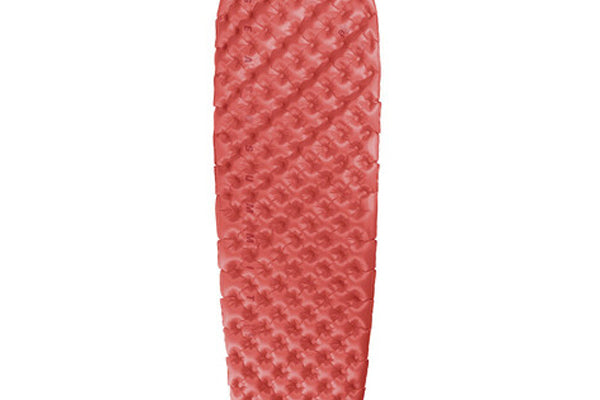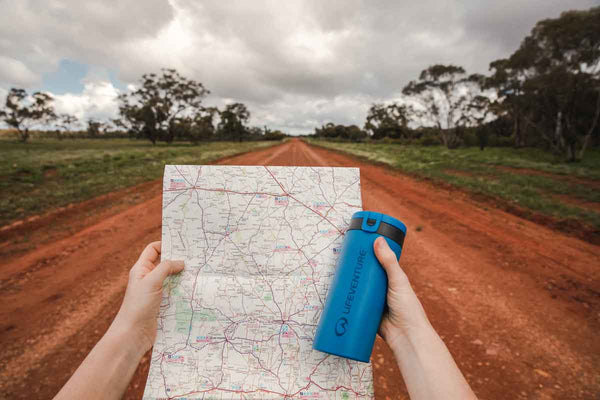
Tec-splenations: Sleeping Mats and R-value
When we leave our comfortable, springy mattresses at home and venture into the great outdoors, finding a suitable replacement is a pretty high priority--or should have been, as we soon discover during our first night! While sleeping on a bed of pine needles or leaves has its charms, they are not always easy to find at the drop of a hat. And when you've woken up once with silvery slug trails across your sleeping bag or red from being prickled all night, you'll doubtless come to agree with us that it is a sleeping solution best kept for survival situations.
Delightfully comfy, but makes the birds sad
However, the old "burrow into a soft pile of leaves" idea is a very sound one, in one sense, and is touted for precisely one good reason: It provides insulation. Yes, while you might imagine the most important reason to have a sleeping mat is so that you can have a comfortable night's sleep (and that is, indeed, an important reason), of arguably much higher importance is the fact that a sleeping mat is an integral part of keeping you warm at night. The old pine-needle bed, as prickly as it might be, does just that in a survival situation - it provides a buffer between you and the heat-sucking ground.
Bear with me for a brief technical reminder.There are four main ways of losing heat--five, if you count respiration, but there's not a lot you can do about that--so don't try holding your breath! They are:
- Conduction (heat moving from a warmer to a cooler object through direct contact)
- Convection (Being heated causes mass amounts of air or water to move away from the source of heat, carrying heat away with it)
- Radiation (Transfer of heat via electromagnetic waves - think of the sun!)
- Evaporation. (Pretty clear.)
Please note: When we talk about the warmth of a sleeping mat, a fundamental point to remember is that the mat is part of your whole sleeping system--the clothes you're sleeping in, your sleeping bag, your tent, and so on. That point is important to bear in mind when we talk about the warmth of different sleeping mats because you're unlikely to ever use one on its own! So it might be that you end up going for a mat which doesn't have the highest R-value (we'll come to that), because you know that you have a very warm sleeping bag and rarely go out when the temperature drops below 5°.
The laws of thermodynamics demand that heat move from a hotter object to a cooler, so if something cold is touching you (say, your spouse's feet in bed), it will adsorb heat from you until you are at the same temperature (unless you fling them off first). Sure, it's not pleasant when a pair of cold feet land on you in the middle of the night, but warming up a body part is at least relatively easy. However, warming up the earth you are sleeping on--which is connected to all the earth around it--is, of course, impossible.
When it comes to sleeping mats and heat loss, we are primarily concerned with heat loss through conduction. There are a couple of ways that a sleeping mat works to stop you losing heat to the ground. First of all, as already stated, it provides a buffer between you and the ground. Secondly, it can use insulation to increase your warmth, instead of just stopping the loss of heat.
Randy Verniers, who served as Marmot's Director of Fabrics and Technologies for 15 years, defined insulation as "Trapped air that stops heat moving away from the heat source", and that's an excellent definition! Most of us at some point have probably imagined that it is the actual down or synthetic fibre--and their cuddly fluffiness, of course!--which are keeping us warm. But think of the bed of pine needles again! Definitely not fluffy. What is actually keeping you warm is all the hundreds of thousands of little pockets of air which, having been heated up by your body, can't escape. Air is, in fact, an excellent insulator, if you can keep it from going anywhere--something that sleeping mat designers place tremendous focus on.
Of course, once you start looking at types of insulation used in sleeping mats, and their respective levels of warmth, you will soon run into the recondite "R-value". Fortunately, although the physics of thermal regulation are scientific-sounding and use words and expressions alarmingly reminiscent of high school physics, you don't need to know any of that. The significance of R-value can be easily summarized and condensed, as follows:
R-value is a material's resistance to heat flow.
There! Simple, right?
Ok, there's a little bit more. But not too much, and not really more complicated than that. The more a given fabric--or object--resists heat flowing through it, the higher its R-value. So at the very least, when looking at a collection of sleeping mats, the one with the highest R-value (which so far, for sleeping mats, has not gone higher than an 9.5) is going to keep you the warmest.
Doesn't seem complicated, does it?The first difficulty you are likely to find, after that, is translating it into the practical terms. If you were here, you'd probably have nodded understandingly up until now, and then asked "Well, alright, but how high of an R-value do I want, then?" After enduring all those explanations and lectures on R-value and insulation, you don't want to just toss it out a window. But it is important here to take a step back and not base your decision solely on the R-value of a mat.
When you purchase a sleeping mat, you want to consider what type of activity you are doing, where you are going, and what the weather will be. Not all of those relate to temperature. Will you be travelling over very rocky terrain, where a mat might easily be punctured? How much weight do you want to carry? Are you determined to shave every last ounce from your pack, up to and possibly including cutting the end off your toothbrush?
Sleeping mats that are filled with down (such as the Exped DownMat) are, thus far, the warmest mats out there, with the Exped DownMat 9 having an R-value of 8. The most basic sleeping mat you can get, one made from closed-cell foam (usually, the ubiquitous "blue foamy" mats), are the coolest, with an R-value between 1 and 2. Other mats, such as Exped's SynMat 7.5 (filled with synthetic fibre insulation) or the Thermarest Trail Pro, fall somewhere in between, with an R-value of 4 and 3.8, respectively. However, there is always a toss-up for weight as well. The Exped DownMat 9 is 990 grams--definitely the warmest for its weight, but still fairly heavy--where a closed cell foam can easily be around 250 grams. Again, other mats fall somewhere in between--the SynMat 7.5 is 660 grams, and the Thermarest Trail Pro 910.
Thermarest cutaway with coin for size comparison
Within a given brand, there can also be significant variation, with Thermarest's heaviest mat, the Luxury Camp, weighing in at a substantial 1420 grams (yes, that's 1.42 kilos!) but with the benefit of an R-value of 7; and its lightest self-inflating mat, the ProLite, weighing 560 grams with an R-value of 2.2. Thermarests are also known for being self-inflating, meaning that if you open the valve and unroll it, within a couple of minutes, the die-cut foam inside has expanded and sucked it quite full of air--depending on the mat, you might to give it one or two extra breaths to 'top it up', but not more than that. On the other hand, an Exped DownMat or SynMat needs pumping up--as easy as that can be, with many of them having either an inbuilt pump, or a surprisingly small pump available as an accessory.
Until recently, all backpacking mats (excluding, we should mention, blow-up mats like Coleman mats - which, while extremely comfortable and fantastic for car camping or when you have a guest, are NOT backpacking mats!)--as we said, all mats had some sort of filling to assist as insulation--whether it was down, synthetic, or foam. Thermarest recently set a whole new standard, however, in what we call "Performance Air", when they came out with the NeoAir. Using reflective barriers within the mat to return your body heat (instead of down or synthetic or fibers), the NeoAir proves the superior insulating capability of air by nonetheless having an R-value of 2.5, and a pleasingly low weight of 410 grams.
Undoubtedly, by this point you have gathered that your choices in sleeping mats are many and varied. However, hopefully by now you have managed to make sense of the sometimes perplexing array of technical options. Ultimately, the best way to make your decision--apart from borrowing mats from friends until you find one you like--is to come in to the store and take some time to test them all out. Comfort is in the hip of the recliner, so lie on them, get a feel for what is comfortable for you, and, as always, refer to the friendly staff if you have any questions or queries.
Happy sleeping!







